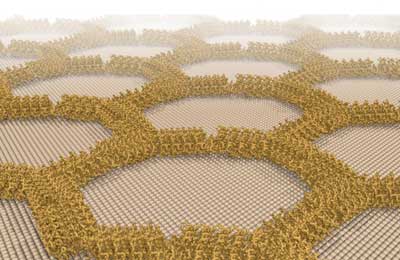| Jul 11, 2019 | |
Designer proteins form wires and lattices on mineral surface(Nanowerk News) Artificial proteins engineered from scratch have been assembled into nanorod arrays, designer filaments and honeycomb lattices on the surface of mica, demonstrating control over the way proteins interact with surfaces to form complex structures previously seen only in natural protein systems. |
|
| The study, a collaborative project led by scientists at the Department of Energy’s Pacific Northwest National Laboratory and the University of Washington School of Medicine, provides a foundation for understanding how protein-crystal interactions can be systematically programmed. This sets the stage for designing novel protein-inorganic hybrid materials. | |
| The goal of the research, published in the journal Nature ("Controlling protein assembly on inorganic crystals through designed protein interfaces"), was to engineer artificial proteins to self-assemble on a crystal surface by creating an exact match between the pattern of amino acids in the protein and the atoms of the crystal. The ability to program these interactions could enable the design of new biomimetic materials with customized colors, chemical reactivity or mechanical properties, or to serve as scaffolds for nano-scale filters, solar cells or electronic circuits. | |
 |
|
| Researchers have created synthetic proteins, shown in orange, that form honeycomb-like structures on the atomic surface of mica, shown here as tan spheres. (Image: PNNL) | |
| “Biology has an amazing ability to organize matter from the atomic scale all the way up to blue whales,” said co-first author Harley Pyles, a graduate student at the UW Medicine’s Institute for Protein Design. “Now, using protein design, we can create brand new biomolecules that assemble from atomic- to millimeter-length scales. In this case, mica ¾ a naturally occurring crystal ¾ is acting like a big Lego® baseplate on top of which we are assembling new protein architectures.” | |
| The design of the new mineral-binding molecules was inspired by proteins that interact with ice. At the molecular scale, ice is flat and contains an atomically precise pattern of rigid water molecules. In nature, proteins match these patterns to enable them to stick to the ice. | |
| The team used computational molecular design to engineer new proteins with customized patterns of electrical charge on their surfaces, as if they were nano-size Lego® blocks perfectly matched to the mica baseplate. Synthetic genes encoding these designer proteins were placed inside bacteria, which then mass produced the proteins in the laboratory. | |
| The researchers found that different designs formed different patterns on the mica surface. By redesigning parts of the proteins, the team was able to produce honeycomb lattices in which they could digitally tune the diameters of the pores by just a few nanometers, which is about the width of a single DNA double helix molecule. | |
| “This is a milestone in the study of protein-material interfaces,” said David Baker, director of the IPD, a professor of biochemistry at the University of Washington School of Medicine and co-senior author of the research. “We achieved an unprecedented degree of order by designing units that self-assemble into aligned rows of nanorods, precise hexagonal lattices and exquisite single-molecule-wide nanowires.” | |
| The research was enabled by the use of atomic force microscopy, which uses a tiny needle to map molecular surfaces, much like how the needle from a record player reads information in the grooves of a vinyl record. The AFM results show that the architectures formed by the proteins are controlled by a subtle balance between the designed interactions with the mica surface and forces that only appear when large numbers of proteins act in concert, like logs on a river. | |
| “Even though we designed specific atomic-level interactions, we get these structures, in part, because the proteins are crowded out by the water and are forced to pack together,” said James De Yoreo, a materials scientist at PNNL and co-director of NW IMPACT, a joint research endeavor between PNNL and the UW to power discoveries and advancements in materials. “This was unexpected behavior and demonstrates that we need to better understand the role of water in ordering proteins in molecular-scale systems.” | |
| Being able to create functional protein filaments and lattices from scratch could also allow creation of entirely novel materials, unlike any found in nature. The findings could lead to new strategies for synthesizing semiconductor and metallic nanoparticle circuits for photovoltaic or energy storage applications. Or alternatively, the protein honeycombs could be used as extremely precise filters, according to co-first author Shuai Zhang, a postdoctoral researcher at PNNL. “The pores would be small enough to filter viruses out of drinking water or filter particulates out of air,” said Zhang. |
| Source: Pacific Northwest National Laboratory | |
|
Subscribe to a free copy of one of our daily Nanowerk Newsletter Email Digests with a compilation of all of the day's news. |
